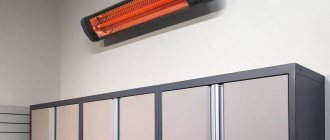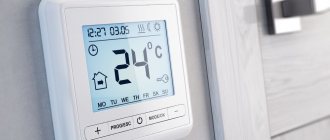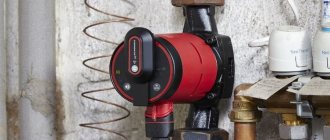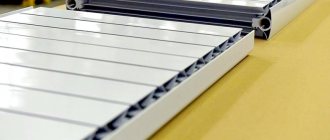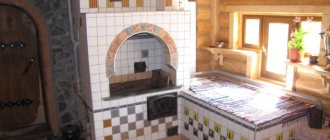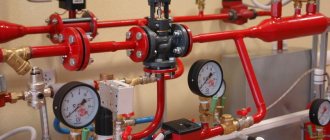I was faced with the repair of a convection micathermal heater BIMATEK PH300 (external view in the photo below), and decided to search the Internet for background information on this, as they say everywhere, the latest achievement in the field of home heaters. I didn’t find anything concrete, but I read a lot of fiction and fables about heaters. I decided to write an article to dispel some misconceptions about electric heaters that have no physical basis.
In our country, the beginning of the heating season, contrary to common sense and medical indications, begins when the average daily air temperature outside the window drops below 8˚C. During this cold season, the indoor temperature drops below 18˚C. People have to put on warm clothes, but this still does not save them from colds and colds. There are not so many lucky people who have an individual apartment heating system, so to create comfortable living conditions, most people are forced to use electric heaters. The issue of heating rooms is especially acute if there are small children and elderly people in the family.
There is a huge selection of electric heating devices on sale. In order to buy exactly the one that is best suited for your case, you need to know what types of electric heaters there are, what their differences are, advantages and disadvantages. Then in the store you will only have to decide on the appearance of the heater.
Introduction
With the onset of golden autumn, when utility workers have not yet woken up, the temperature in our apartments sometimes drops to indecent levels.
In such an extremely unpleasant situation, it is necessary to act somehow. Which home heater is the most economical and inexpensive? But what to do if electricity bills are getting higher every year, as are prices in stores, how can you escape from this terrible cold? The only option left is to choose the most economical, inexpensive, efficient heater with the highest efficiency, and we will try to help you in this matter.
Oil radiator
Perhaps oil heaters for home can be called the most popular. Rated power varies from 1 to 2.5 kW. In a hermetically sealed housing filled with oil, there is a spiral, the heating of which leads to heat transfer to the oil. The hot oil, in turn, transfers heat to the housing, from which the heat is dissipated into the air. Oil heaters are well suited for heating apartments or cottages. When a certain air temperature is reached, the heater automatically turns off, and when it drops below a certain threshold, it starts again. The temperature of the radiator housing usually does not exceed 60 degrees Celsius. The disadvantages of such a heater: a rather large body and a long warm-up time.
Types of heaters
Today on the market there are a great variety of different electric heating systems, from simple small heaters to complex systems of heated floors, walls or ceilings with remote control coupled with smart home systems, but all of them can be divided into just a few types:
- Electric (fan heaters)
- Electric fireplaces
- Oil radiators
- Convectors or convection heaters
- Quartz panels
- Infrared. They differ by type of heating element: halogen, carbon, quartz, micathermic (best efficiency)
Principle of operation
First, you need to remember the principle of operation of heaters. Fan heaters are considered the simplest devices; heating occurs due to the distribution of hot air by a fan through an incandescent lamp; the efficiency is quite low.
The principle of electric fireplaces is similar to fan heaters; as a rule, such devices are stationary and have rather a decorative component; the efficiency of such devices is at an average level.
In oil radiators, heat is distributed by heating the oil inside the heater using heating elements. Heating takes quite a long time, but cooling is noticeably slower. Due to the smooth heating of the oil inside the radiator grille, such batteries cannot be called economical, and later you will find out why, the efficiency is low. Even in some European countries they are assigned class C for energy efficiency.
Convectors operate on the principle of convection by circulating air inside the room through the heater. Heavy cold air falls down, is captured by the convector, heats up and rises, and as it rises it displaces the cold air. The efficiency of such devices is quite high.
Quartz panels are an electric heating element enclosed between artificial stone panels; the efficiency is average. First, energy is expended on heating the plates and further slow heat transfer occurs from these plates.
Infrared heaters are equipped with special emitters (lamps) that emit infrared rays that are invisible to humans and primarily heat the surrounding objects, rather than the air around them. They differ in the type of lamp emitters : halogen, carbon, quartz. Such devices are more economical than oil and electric fireplaces. The efficiency is quite high, see table below.
Infrared with micathermic heating elements have appeared quite recently. This is an innovative type of infrared heaters with the highest efficiency. Unlike conventional infrared heaters, in such heaters the source of thermal energy is a special design made of Micatherm panels, which distributes invisible, safe infrared radiation. As a result of exposure to such radiation, surrounding objects, rather than the environment, heat up.
Electric convector
Visually and in terms of their performance, convectors are very similar to oil heaters, but are much better suited for installation as central heating. This type of heater can be used in any room. This device is quite unpretentious, is not afraid of moisture and works perfectly without grounding, which makes it possible to use it around the clock.
The principle of operation is based on the movement of air through a special heating element. The constant movement of air is due to the fact that cold air is always below warm air. From this we can derive useful advice: the lower the convector is installed, the higher the temperature it can provide.
Efficiency of the main types of home heaters
Everyone knows what efficiency is, this is the difference between the energy expended and the energy produced. When calculating the coefficient, we tried to provide the most detailed answer in tabular form . Since, in addition to the energy component, there are also financial costs for the purchase of the device itself, electricity costs, the calculation is made taking into account these factors.
The table shows the average values obtained from tests of various types of heaters (thanks to one well-known store for providing testing equipment). The cost for 1 kW of energy is 4 rubles. Heating took place for 1 hour in a furnished room of 18 square meters with an initial temperature of 22 degrees C. Heater power 1500 W. Control type – electronic.
| View | Average price, r | Declared maximum power, W | Temperature change over 1 hour, gr. WITH | KW consumed according to the meter | Cost of consumed electricity, p |
| Fan heater | 1250 | 1500 | +3,9 | 1,69 | 6,76 |
| Oil | 3200 | 1500 | +5,1 | 1,74 | 6,96 |
| Convector | 3540 | 1500 | +6,2 | 1,52 | 6,08 |
| Infrared | 3580 | 1500 | +6,1 | 1,22 | 4,88 |
| Micathermic | 7800 | 1500 | +7,0 | 1,24 | 4,96 |
The obtained figures are approximate, since many important factors influencing the result are not taken into account, such as: a single brand of the manufacturer, humidity in the room, the model of the heater itself, direction, voltage in the electrical circuit, etc.
But nevertheless, the figures turned out to be the following; the highest efficiency was obtained from convectors, infrared, and micathermic heaters. The fan heater was barely able to heat the room by 4 degrees.
The oil radiator heated the room quite well; after the end of the experiment, the room continued to heat up and remained heated longer than others, so it should not be written off due to high power consumption.
In addition to the electronic type of control, there are also mechanical (outdated) and inverter (the most modern and economical). If we compare the electricity consumption of similar heaters with different control modules, the following figures come out:
mechanical - 0% savings, the electronic unit allows you to save 30% in contrast to the mechanical one, the inverter control unit is the most economical, this method of thermoregulation allows you to save up to 80% of electricity compared to mechanical regulators.
Inverter thermostat
The cost of heaters with inverter units can vary from 8,000 to 30,000 rubles. In the long term, as a rule, such costs pay off. More details in the video:
Why some heaters are more economical than others, pros and cons
The fact is that different heaters use different methods of heating the room, some use heating elements, others use infrared radiation and oil coolants.
The primary most important factor influencing savings is the correct selection of a heater of the required power for a given room area. For example, if you try to heat 400 m2 with a fan heater for 900 rubles, you may not only not heat anything, but also get a good electricity bill at the end of the month , see the table below .
| Room area, sq.m | Power (Watts, W) |
| 5,0-6,0 | 500-750 |
| 7,0-9,0 | 750-1000 |
| 10,0-12,0 | 1000-1250 |
| 12,0-15,0 | 1250-1500 |
| 15,0-18,0 | 1500-1750 |
| 18,0-25,0 | 1750-2000 |
| 25,0-30,0 | 2000-2500 |
| 30,0-35,0 | 2500-2900 |
Important! If you choose a heater as a non-main source of heat, for example, for the spring-autumn period. One order of magnitude less choice is enough For example, 30sq.m-2000W . Another situation is if the main heating source is not enough for you, for this you need to make simple calculations and acquire a suitable energy-saving heater designed for a smaller area.
Also , do not forget that not all heating systems distribute heat evenly around themselves, there are directional, all-round, there are floor, wall, ceiling, they all have their pros and cons. Let's look at the advantages and disadvantages of the most popular ones:
Fan heaters
- pros
Mobility, democracy, fairly quick heating of the room
- minuses
Noisy, dry the air, raise dust, burn oxygen, cannot be left unattended, average efficiency
Oily
- pros
Slow cooling, silent operation, thermostat, overheating protection
- minuses
Slow heating, low efficiency, body heating
Convectors
- pros
Silence, safe heating of the case, thermostat, high efficiency
- minuses
They dry out the air, burn out oxygen, and become clogged with dust.
Infrared
- pros
Quiet, economical, do not dry out or burn oxygen, fast heating
- minuses
Expensive
Micathermic
- pros
High efficiency, maintaining a uniform microclimate
- minuses
Increased sensitivity to power overloads, price
This list shows only the main advantages and disadvantages. When choosing a heater, you must also pay attention to the manufacturer’s brand, warranty period, its own unique properties, energy efficiency class, ease of transportation, safety for people, sensitivity to temperature changes, cord length, appearance.
Gas ceramic heating devices
Units of this type consist of a housing in which a liquefied gas cylinder (standard or universal household) is arranged, a burner connected to it by a hose through a reducer, an automatic ignition device, a ceramic emitter and security system devices.
The operating principle of the heater is based on infrared radiation generated by a ceramic emitter, which is heated by the burner when the gas supplied to it is burned.
Economical gas ceramic home heaters: on the left - Timberk TGH 4200 O3, on the right - ProRab Home.
Considering that gas heaters are high-risk equipment, the safety of operation of these infrared devices is ensured by systems that automatically stop the supply of gas fuel when the device overturns, the burner flame is blown out, and gas pressure deviates from the standard value and exceeds the permissible value.
The profitability of these heaters is not due to low energy consumption, but to the relative cheapness of gas fuel, but choosing a ceramic heating unit on gas for use in a country house or country house is a rational decision, since it does not require the installation of an internal gas pipeline, and replacing cylinders is not a frequent procedure and not complicated.
Important! The release of some substances into the air during the combustion of household liquefied gas (propane, butane) is minimal, therefore gas heaters of this design do not require connection to a ventilation system, but the unit’s consumption of oxygen in the room during fuel combustion must be compensated by periodic ventilation of the heated room.
To keep the cost of gas fuel as low as possible, we choose gas based on the season - in the fall and spring it is better to use butane, which has a lower calorie content, and in winter, in cold weather, it is better to use propane.
The best inexpensive, economical heaters according to experts, TOP-15
When choosing a heater, it is often difficult to understand just by looking at it in a store whether it is good or not, and testing for functionality is also not enough. Before going to the store, it is important to know exactly which of the heaters will actually cope with its task, and which one should not be considered. For this purpose, we have compiled a rating of the best and inexpensive heaters, suitable for a home, cottage or apartment, for a room of 20 square meters, with a power of 1000 to 2000 W. This rating is based on expert opinion and experience of use by other users. When choosing, also pay additional attention to reviews from other users and the cost in retail stores.
Electric (fan heaters)
Electrolux EFH/S-1115 1500 W (1100 – 4000 RUR)
Zanussi ZFH/C-408 1500 W (1450 – 4000 RUR)
Ballu BFH/C-31 1500 W (790 – 3600 RUR)
Oil radiators
Ballu Classic BOH/CL-09 2000 W (2800 – 3300 RUR)
Electrolux EOH/M-6209 2000 W (3600 – 4900 RUR)
Timberk TOR 21.1507 BC/BCL 1500 W (3400 – 3950 RUR)
Convectors or convection heaters
Ballu Enzo BEC/EZER-1500 1500 W (4230 – 4560 RUR)
Electrolux ECH/AG2-1500 T 1500 W (3580 – 3950 RUR)
Electrolux ECH/AS-1500 ER 1500 W (4500 – 5800 RUR)
Infrared
Ballu BIH-LW-1.5 1500 W (2390 – 2580 RUR)
Almac IK11 1000 W (3650 – 3890 RUR)
Timberk TCH A1N 1000 1000 W (4250 – 4680 RUR)
Infrared micathermic
Polaris PMH 2095 2000 W (RUB 7250 -8560)
Polaris PMH 2007RCD 2000 W (6950 – 8890 RUR)
De'Longhi HMP 1000 1000 W (6590 – 7250 RUR)
Warm floor or heater, which is better and more economical? Video
Many people wonder what is better: an energy-saving heater or a heated floor system; this topic is especially relevant for owners of private houses or residents of the first floors of multi-story buildings.
So, what is a heated floor ? It is a heating system that heats a room from bottom to top, from floor to ceiling. Electric panels (mats, films, amorphous tapes) or hydraulic systems are used as heaters; accordingly, the heating principle is also different, infrared and convection. The system is mounted under various floor coverings, tiles, laminate, linoleum, PVC tiles, concrete.
Like all heaters, heated floors have their advantages and disadvantages, which you should pay attention to in order to understand what is best for the room. If we compare it with convection, the heat from the radiator rises up, cools down at the ceiling and falls down, and so on in a circle, therefore, in the upper part of the room it is much warmer than in the lower part, and in order to increase the heat in the area of the feet, it is necessary to increase the power of the radiator.
Unlike radiators, heated floors distribute heat over a larger area of the room evenly on the lower surface, thanks to this arrangement, savings on coolant costs , the feeling of warmth in the house increases by an average of 2 - 3 degrees C, and energy savings reach 15-20% compared to radiators. in more detail .
The disadvantages of heated floors include a long heating and cooling period. As the outside temperature changes, the indoor temperature does not always have time to change quickly. In order to install heated floors, it is necessary to rebuild the floor covering or provide for it in advance when renovating or building a house.
Important! The use of MDF and chipboard furniture can lead to the release of harmful substances from the material.
So which is more economical? When choosing heaters, you should definitely pay attention to the underfloor heating system. The best use case is combined heating systems, heated floors where needed in conjunction with radiators.
In case of a long period of low temperatures outside the window, the use of heated floors is certainly more profitable than wall heaters and will, over time, pay for the costs of installation and screeding. During short-term cold snaps, a local expensive or cheap heater is better suited.
Heat fan
This type of heater belongs to the budget category. As a rule, fan heaters are used to quickly heat air in small isolated rooms. Such devices are small in size and fit equally well both on the floor and on the wall. A fan heater is the best answer to the question of how to choose a heater for a room. The air entering the fan heater is heated, receiving heat from the hot coil, after which it is distributed throughout the room under the action of the fan. For better heating, the fan can be rotated. Heat fans heat the air very quickly and distribute heat well throughout a given volume. The built-in thermostat allows the device to work automatically. Disadvantage: Quite loud noise produced when operating in fast mode.
